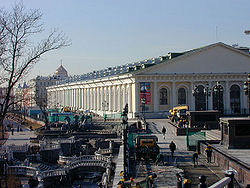
Moscow Manege
Encyclopedia

Red Square
Red Square is a city square in Moscow, Russia. The square separates the Kremlin, the former royal citadel and currently the official residence of the President of Russia, from a historic merchant quarter known as Kitai-gorod...
. A manège is an indoor riding academy.
Designed by Spanish engineer Agustín de Betancourt
Agustín de Betancourt
Agustín de Betancourt y Molina was a prominent Spanish-Canarian engineer, who worked in Spain, France and Russia. His work ranged from steam engines and balloons to structural engineering and urban planning...
with a unique roof without internal support for 45 m, it was erected from 1817 to 1825 by the Russian architect Joseph Bové
Joseph Bové
Joseph Bové was a Russian neoclassical architect with Italian roots who supervised reconstruction of Moscow after the Fire of 1812.-Biography:...
, who clothed it in its Neoclassical
Neoclassical architecture
Neoclassical architecture was an architectural style produced by the neoclassical movement that began in the mid-18th century, manifested both in its details as a reaction against the Rococo style of naturalistic ornament, and in its architectural formulas as an outgrowth of some classicizing...
exterior, an order of Roman Doric columns
Doric order
The Doric order was one of the three orders or organizational systems of ancient Greek or classical architecture; the other two canonical orders were the Ionic and the Corinthian.-History:...
enclosing bays of arch-headed windows in a blind arcade, painted white and cream yellow. The roof, with its internal rafters and beams exposed, rests on external columns of the Manege.

Hector Berlioz
Hector Berlioz was a French Romantic composer, best known for his compositions Symphonie fantastique and Grande messe des morts . Berlioz made significant contributions to the modern orchestra with his Treatise on Instrumentation. He specified huge orchestral forces for some of his works; as a...
and Nikolai Rubinstein performed at the Manege before a crowd of 12,000. During the Soviet years, the building was used as an art gallery. It was there that Nikita Khrushchev
Nikita Khrushchev
Nikita Sergeyevich Khrushchev led the Soviet Union during part of the Cold War. He served as First Secretary of the Communist Party of the Soviet Union from 1953 to 1964, and as Chairman of the Council of Ministers, or Premier, from 1958 to 1964...
(in)famously chided avant-garde artists for promoting degenerate art
Degenerate art
Degenerate art is the English translation of the German entartete Kunst, a term adopted by the Nazi regime in Germany to describe virtually all modern art. Such art was banned on the grounds that it was un-German or Jewish Bolshevist in nature, and those identified as degenerate artists were...
.
On 14 March 2004 the building caught fire and burnt out, killing two firefighters. The wooden beams and rafters collapsed, leaving the walls remaining on site. The official investigation concluded that a short-circuit caused the fire. On 18 February 2005 the restored Manege resumed its activity as an exhibition hall by mounting the same exposition that had been scheduled on the day of its fire.

